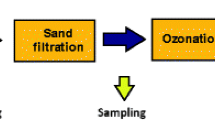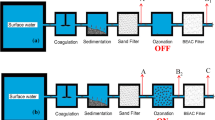Abstract
The aim of this study was to investigate the fate of natural organic matter (NOM) and subsequent changes during the various treatment processes at a full-scale Drinking Water Treatment Plant (DWTP). Monthly sampling campaigns were conducted for 1 year at six sites along DWTP of Thessaloniki, Northern Greece including raw water from the Aliakmonas River that supplies DWTP and samples from various treatment processes (pre-ozonation, coagulation, sand filtration, ozonation, and granular activated carbon (GAC) filtration). The concentration of NOM and its characteristics as well as the removal efficiency of various treatment processes on the basis of dissolved organic carbon, UV absorbance, specific ultra-violet absorbance, fluorescence intensity, hydrophobicity, biodegradable dissolved organic carbon, and formation potential of chlorination by-products trihalomethanes (THMs) and haloacetic acids (HAAs) were studied. The concentration of dissolved organic carbon (DOC) in reservoir of the Aliakmonas River ranged from 1.46 to 1.84 mg/L, exhibiting variations regarding UV, fluorescence, and hydrophobic character through the year. Along DWTP, a significant reduction of aromatic, fluorophoric, and hydrophobic character of NOM was observed resulting in significant elimination of THM (63 %) and HAAs (75 %) precursors.









Similar content being viewed by others
References
APHA, AWWA, WEF (1999a) Standard methods for the examination of water and wastewater, Method 5710Β: Trihalomethane Formation Potential (THMFP). American Public Health Association, American Water Works Association, Water environment Federation, Washington, DC
APHA, AWWA, WEF (1999b) Standard methods for the examination of water and wastewater, Method 5710D: formation of other disinfection by-products (DBPs). American Public Health Association, American Water Works Association, Water environment Federation, Washington, DC
Arditsoglou A, Voutsa D (2010) Partitioning of endocrine disrupting compounds in inland waters and wastewaters discharged into the coastal area of Thessaloniki, Northern Greece. Environ Sci Pollut Res 17:529–538
Bonnet MC, Welte B, Montiel A (1992) Removal of biodegradable dissolved organic carbon in a water treatment plant. Water Res 26(12):1673–1680
Bose P, Reckhow DA (2007) The effect of ozonation on natural organic matter removal by alum coagulation. Water Res 41:1516–1524
Chang EE, Chiang P-C, Ko Y-W, Lan W-H (2001) Characteristics of organic precursors and their relationship with disinfection by-products. Chemosphere 44:1231–1236
Chen J, Gu B, LeBoeuf EJ, Pan H, Dai S (2003) Fluorescence spectroscopic studies of natural organic matter fractions. Chemosphere 50:639–647
Chen C, Zhang X, He W, Lu W, Han H (2007) Comparison of seven kinds of drinking water treatment processes to enhance organic material removal: a pilot test. Sci Total Environ 382:93–102
Duarte RMBO, Santos EBH, Duarte AC (2003) Spectroscopic characteristics of ultrafiltration fractions of fulvic and humic acids isolated from an eucalyptus bleached Kraft pulp mill effluent. Water Res 37:4073–4080
Edzwald JK, Tobiason JE (1999) Enhanced coagulation: USA requirements in a broader view. Water Sci Technol 40(9):63–70
EPA (1998) Method 551.1: determination of chlorinated disinfection by-products, chlorinated solvents and halogenated pesticides/herbicides in drinking water by liquid-liquid extraction and gas chromatography with electron capture detection. USEPA, Office of Water, Technical Support Center, 26W. Martin Luther King Dr., Cincinnati, OH 45268
Escobar IC, Randall AA (2001) Assimilable organic carbon (AOC) and biodegradable dissolved organic carbon (BDOC): complementary measurements. Water Res 35:4444–4454
Fu P, Wu F, Liu C, Wang F, Yue L, Li W, Guo Q (2007) Fluorescence characterization of dissolved organic matter in an urban river and its complexation with Hg(II). Appl Geochem 22:1668–1679
Gibert O, Lefèvre B, Fernández M, Bernat X, Paraira M, Pons M (2013) Fractionation and removal of dissolved organic carbon in a full-scale granular activated carbon filter used for drinking water production. Water Res 47(8):2821–2829
Gough R, Holliman P, Willis N, Freeman C (2014) Dissolved organic carbon and trihalomethane precursor removal at a UK upland water treatment works. Sci Total Environ 468–469:228–239
Hur J, Nguyen HV-M, Lee B-M (2014) Influence of upstream land use on dissolved organic matter and trihalomethane formation potential in watersheds for two different seasons. Environ Sci Pollut Res 21:7489–7500
Jurado-Sánchez B, Ballesteros E, Gallego M (2014) Occurrence of carboxylic acids in different steps of two drinking-water treatment plants using different disinfectants. Water Res 51:186–197
Kim H-C, Yu M-J (2007) Characterization of aquatic humic substances to DBPs formation in advanced treatment processes for conventionally treated water. J Hazard Mater 143:486–493
Korshin GV, Li C-W, Benjamin MM (1997) Monitoring the properties of natural organic matter through UV spectroscopy. Water Res 317:1787–1795
Krasner SW, Weinberg HS, Richardson SD, Pastor SJ, Chinn R, Sclimenti MJ, Onstad GD, Thruston AD Jr (2006) Occurrence of a new generation of disinfection byproducts. Environ Sci Technol 40:7175–7185
Leenheer JA, Croué J-P (2003) Characterizing aquatic dissolved organic matter. Environ Sci Technol 37(1):18A–26A
Li A, Hu J, Li W, Zhang W, Wang X (2009) Polarity based fractionation of fulvic acids. Chemosphere 77:1419–1426
Matilainen A, Sillanpää M (2010) Removal of natural organic matter from drinking water by advanced oxidation processes. Chemosphere 80:351–365
Matilainen A, Lindqvist N, Korhonen S, Tuhkanen T (2002) Removal of NOM in the different stages of the water treatment process. Environ Int 28:457–465
Matilainen A, Iivari P, Sallanko J, Heiska E, Tuhkanen T (2006) The role of ozonation and activated carbon filtration in the natural organic matter removal from drinking water. Environ Technol 27(10):1171–1180
Matilainen A, Vepsälainen M, Sillanpää M (2010) Natural organic matter removal by coagulation during drinking water treatment: a review. Adv Colloid Interf Sci 159:189–197
Matilainen A, Gjessing ET, Lahtinen T, Hed L, Bhatnagar A, Sillanpää M (2011) An overview of the methods used in the characterisation of natural organic matter (NOM) in relation to drinking water treatment. Chemosphere 83:1431–1442
Meng F, Huang G, Yang X, Li Z, Li J, Cao J, Wanga Z, Sun L (2013) Identifying the sources and fate of anthropogenically impacted dissolved organic matter (DOM) in urbanized rivers. Water Res 47(14):5027–5039
Molnar J, Agbaba J, Dalmacija B, Roncevic S, Prica M, Tubic A (2012) Influence of pH and ozone dose on the content and structure of haloacetic acid precursors in groundwater. Environ Sci Pollut Res 19:3079–3086
Özdemır K (2014) Characterization of natural organic matter in conventional water treatment processes and evaluation of THM formation with chlorine. Sci World J 2014:Article ID 703173
Papageorgiou Α, Voutsa D, Papadakis N (2014) Occurrence and fate of ozonation by-products at a full-scale drinking water treatment plant. Sci Total Environ 481:392–400
Pei Y, Yu J, Guo Z, Zhang Y, Yang M, Zhang J, Junji H (2007) Pilot study on pre-ozonation enhanced drinking water treatment process. Ozone Sci Eng 29(5):317–323
Peuravuori J, Koivikko R, Pihlaja K (2002) Characterization, differentiation and classification of aquatic humic matter separated with different sorbents: synchronous scanning fluorescence spectroscopy. Water Res 36:4552–4562
Pifer AD, Fairey JL (2014) Suitability of organic matter surrogates to predict trihalomethane formation in drinking water sources. Environ Eng Sci 31:117–126
Ribau-Teixeira M, Rosa AM, Sousa V (2011) Natural organic matter and disinfection by-products formation potential in water treatment. Water Resour Manage 25:3005–3015
Rodríguez FJ, Marcos LA, Núñez LA, García M (2012) Effects of ozonation on natural organic matter reactivity in adsorption and biodegradation processes—a case study: the Úzquiza Reservoir Water. Ozone Sci Eng 34:342–353
Rodríguez FJ, Schlenger P, García-Valverde M (2014a) A comprehensive structural evaluation of humic substances using several fluorescence techniques before and after ozonation. Part I: structural characterization of humic substances. Sci Total Environ 476–477:718–730
Rodríguez FJ, Schlenger P, García-Valverde M (2014b) A comprehensive structural evaluation of humic substances using several fluorescence techniques before and after ozonation. Part II: evaluation of structural changes following ozonation. Sci Total Environ 476–477:731–742
Santos PSM, Otero M, Santos EBH, Duarte AC (2010) Molecular fluorescence analysis of rainwater: effects of sample preservation. Talanta 82:1616–1621
Servais P, Anzil A, Ventresque C (1989) Simple method for determination of biodegradable dissolved organic carbon in water. Appl Environ Microbiol 55:2732–2734
Servais P, Laurent P, Randon G (1993) Impact of biodegradable dissolved organic carbon (BDOC) on bacterial dynamics in distribution systems. In Proc. AWWA Water Qual. Tech. Conf., Miami, FL
Shu S-H, Yan M, Gao N-Y, He W-J (2008) Molecular weight distribution variation of assimilable organic carbon during ozonation/BAC process. J Water Supply Res Technol AQUA 57:253–258
Sierra MMD, Giovanela M, Parlanti E, Soriano-Sierra EJ (2005) Fluorescence fingerprint of fulvic and humic acids from varied origins as viewed by single-scan and excitation/emission matrix techniques. Chemosphere 58:715–733
Simeonov V, Stratis JA, Samara C, Zachariadis G, Voutsa D, Anthemidis A, Sofoniou M, Kouimtzis T (2003) Assessment of the surface water quality in Northern Greece. Water Res 37:4119–4124
Świetlik J, Dąbrowska A, Raczyk-Stanislawiak U, Nawrocki J (2004) Reactivity of natural organic matter fractions with chlorine dioxide and ozone. Water Res 38(3):547–558
Uyak V, Özdemir K, Toroz I (2008) Seasonal variations of disinfection by-product precursors profile and their removal through surface water treatment plants. Sci Total Environ 390(2–3):417–424
Velten S, Knappe DRU, Traber J, Kaiser H-P, von Gunten U, Boller M, Meylan S (2011) Characterization of natural organic matter adsorption in granular activated carbon adsorbers. Water Res 45(13):3951–3959
Volk C, Renner C, Robert C, Joret JC (1994) Comparison of two techniques for measuring biodegradable dissolved organic carbon in water. Environ Technol 15:545–556
Volk C, Kaplan LA, Robinson J, Johnson B, Wood L, Zhu HW, LeChevallier M (2005) Fluctuations of dissolved organic matter in river used for drinking water and impacts on conventional treatment plant performance. Environ Sci Technol 39:4258–4264
Voutsa D, Manoli E, Samara C, Sofoniou M, Stratis I (2001) A study of surface water quality in Macedonia, Greece: speciation of nitrogen and phosphorus. Water Air Soil Pollut 129:13–32
Wert EC, Rosario-Ortiz FL (2013) Intracellular organic matter from cyanobacteria as a precursor for carbonaceous and nitrogenous disinfection byproducts. Environ Sci Technol 47(12):6332–6340
Xie P, Ma J, Fang J, Guan Y, Yue S, Li X, Chen L (2013) Comparison of permanganate preoxidation and preozonation on algae containing water: cell integrity, characteristics, and chlorinated disinfection byproduct formation. Environ Sci Technol 47:14051–14061
Yang L, Hur J, Zhuang W (2015) Occurrence and behaviours of fluorescence EEM-PARAFAC components in drinking water and wastewater treatment systems and their applications: a review. Environ Sci Pollut Res 22:6500–6510
Yavich AA, Lee K-H, Chen K-C, Pape L, Masten SJ (2004) Evaluation of biodegradability of NOM after ozonation. Water Res 38(12):2839–2846
Zhang W, DiGiano FA (2002) Comparison of bacterial regrowth in distribution systems using free chlorine and chloramine: a statistical study of causative factors. Water Res 36:1469–1482
Zhang T, Lu J, Ma J, Qiang Z (2008) Fluorescence spectroscopic characterization of DOM fractions isolated from a filtered river water after ozonation and catalytic ozonation. Chemosphere 71:911–921
Zhao S, Chen Z, Yang L, Zhai X, Li A (2009a) THM and HAA formation from sequential use ozone and monochloramine to disinfection in the presence of tannic acid. In Proceedings of the International Conference on Energy and Environment Technology (ICEET ‘09), pp. 885–887, Guilin, China, October
Zhao Z-Y, Gu D-J, Li H-B, Li X-Y, Leung KM-Y (2009b) Disinfection characteristics of the dissolved organic fractions at several stages of a conventional drinking water treatment plant in South China. J Hazard Mater 172:1093–1099
Acknowledgments
Authors acknowledge the Company of Water Supply and Sewerage of Thessaloniki for the financial support of this project. Moreover, the authors would like to thank K. Zambetoglou, G. Seretoudi, and V. Mpaltsiotis for their assistance in sampling and information regarding the DWTP operation.
Author information
Authors and Affiliations
Corresponding author
Additional information
Responsible editor: Philippe Garrigues
Rights and permissions
About this article
Cite this article
Papageorgiou, A., Papadakis, N. & Voutsa, D. Fate of natural organic matter at a full-scale Drinking Water Treatment Plant in Greece. Environ Sci Pollut Res 23, 1841–1851 (2016). https://doi.org/10.1007/s11356-015-5433-3
Received:
Accepted:
Published:
Issue Date:
DOI: https://doi.org/10.1007/s11356-015-5433-3




